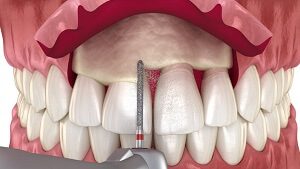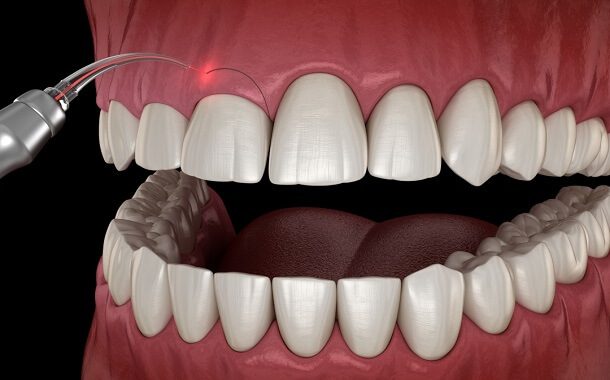The Cost of Gingivectomy
Last Updated on July 28, 2022
Written by CPA Alec Pow | Content Reviewed by ![]() CFA Alexander Popinker
CFA Alexander Popinker
Gingivectomy is a procedure that involves removing inflamed or excessively enlarged gums. It is used as a last resort in the complex therapy of gingivitis and periodontitis, as well as in the treatment of gingival hyperplasia.
Gingivectomy ensures a decrease in the volume of the gingival sacs by removing the affected areas of the gums and forming an aesthetic gingival contour.
In combination with other methods of treating periodontal disease, it allows you to stop the outbreak of infection and eliminate inflammation. After performing a gingivectomy, the gums will regenerate naturally and adapt to the new situation.
How Much Does a Gingivectomy Cost?
The average cost of a gingivectomy is affected by some factors such as the procedure that is used (laser or traditional), the condition of the gums, the dentist, and the geographical location. Expect to pay anywhere between $470 and $950 per quadrant for a gingivectomy procedure or $230 to $380 per tooth.
In case you don’t have health insurance, you will have to pay anywhere between $1,900 and $5,300 to have the gums repaired inside the entire mouth.
Gingivectomy details
The gingival resection procedure can be performed around one or more teeth, depending on the presence of periodontal pockets. At the beginning of the surgery, local anesthesia is performed next to the gum to be removed, then the resection instrument is chosen: scalpel, electrocautery, or laser. Depending on the doctor’s experience, gingival damage, and the area of tissue to be removed, a gingivectomy may take between a few minutes and an hour. At the end of the surgery, the area will be covered with a bandage and the doctor will provide the patient indications for postoperative care.
You might also like our articles about the cost of cavity filling, dental implants, or dental bridges.
In general, in the following days, a soft diet and compliance with the mandatory daily dental brushing sessions are indicated, which will be carried out gently around the sensitive area operated, along with the use of chlorhexidine mouthwash. It is contraindicated to consume hot drinks, hard, salty, spicy foods, and smoking, all of which having an irritating effect and delay postoperative healing.
Types of gingivectomy
Surgical gingivectomy
 The gingival pockets are explored with a periodontal probe and marked. The incision should be made as close to the bone as possible, without exposing it. The tissue is excised, the area is irrigated and the surface of the dental root is examined for limescale or deposits. The granulation tissue is cured, leaving the tooth surface clean and smooth. The area is covered with a bandage.
The gingival pockets are explored with a periodontal probe and marked. The incision should be made as close to the bone as possible, without exposing it. The tissue is excised, the area is irrigated and the surface of the dental root is examined for limescale or deposits. The granulation tissue is cured, leaving the tooth surface clean and smooth. The area is covered with a bandage.
Gingivectomy by electrosurgery
It is performed with a needle electrode, along with a magnifying glass and diamond electrodes that use currents that cut and coagulate. The treatment can cause an unpleasant odor. If the electrocautery touches the bone, it is destroyed. Electrosurgery should be limited to superficial procedures such as the removal of gingival hyperplasia in gingivoplasty, relocation of muscle attachments, and incision of periodontal abscesses.
Electrosurgery allows proper tissue contouring and controls bleeding. It cannot be used in patients who have a cardiac pacemaker.
Laser gingivectomy
The most used lasers in gingivectomy are carbon dioxide and yttrium-aluminum-garnet. Carbon dioxide laser has been used to excise gingival hyperplasia, although healing is delayed compared to healing after surgical gingivectomy.
Gingivectomy by chemosurgery
Chemical agents such as 5% formaldehyde or potassium hydroxide have been described in the past and are not used today. The major disadvantage of the method is the lack of control of the depth of action of chemical agents, so the gingival remodeling is inadequate. Epithelialization and reformation of the gingival attachment of the tooth are very slow.
What are the additional costs?
You will have to go through an oral examination and take an x-ray before the dentist performs the gingivectomy. They will first need to check the condition of your gums and teeth. Also, a periodontic diagnosis examination may be performed to see what type of procedure is necessary and to understand how extended the damage is. Expect to spend anywhere between $380 and $450 for these tests.
Important things to consider
Depending on the initial condition of the gum, the resected surface and the body’s ability to recover, the healing period may be shorter or longer, but in approximately 3-4 weeks the final appearance and harmonious healing of the gum should be visible. Most of the times, the gingivectomy intervention is followed by a gingivoplasty, i.e. remodeling the gingival margin, in order to obtain a result as close as possible to the natural appearance.
The risks of gingivectomy
The main risk of periodontal surgery is the introduction of the infection into the bloodstream. An increased risk is presented by patients who suffer from heart disease, have a deficient immune system, or people who have undergone recent surgery. For this reason, antibiotic treatment can be followed before and after the procedure.
How can I save money?
If you want to save money on this procedure, take into consideration attending a local dental school. Students are well prepared and they are supervised by a licensed professional during the procedure.
Also, you can save money if you have health insurance. Make sure you contact your health insurance provider and ask about how much is covered and under what conditions.
You may be able to save money with one of the discounted plans offered by Dental Plans. This company has agreements with many dentists all over the United States.


Leave a Reply
Want to join the discussion?Feel free to contribute!